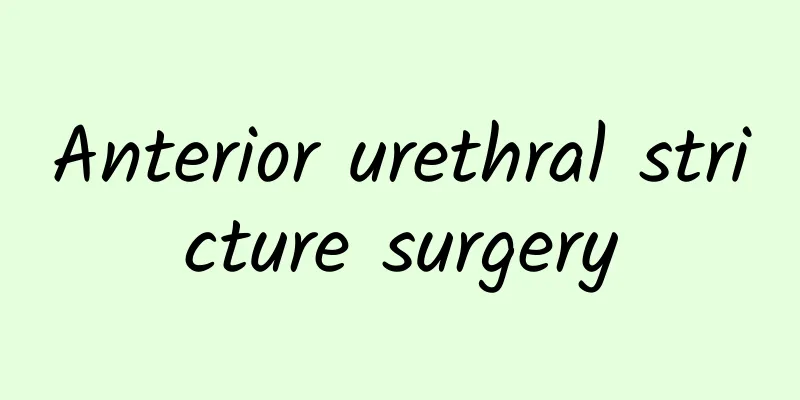Anterior urethral stricture surgery

|
Anterior urethral stenosis is caused by infection of the urinary system or urinary stones. Therefore, everyone should be clear about the cause of anterior urethral stenosis and then treat it according to the cause of the disease. Generally, in cases of anterior urethral stenosis, an internal urethrotomy is required to remove obstructing waste in the urethra or to enlarge the anterior urethral opening to keep the urethra open. Surgery (1) Treatment of posterior urethral stenosis: The treatment of posterior urethral stenosis after urethral injury should be continued for 3 to 6 months. The following surgical methods may be used depending on the extent of the injury: 1) Internal urethrotomy (optional): Use a urethral scalpel (cold knife) or laser to cut the scar at the narrow area, expand the inner diameter of the urethra, and then place a catheter. It is suitable for patients with shorter stenosis segment (<1cm) and mild scar. If the second internal incision is not effective, other treatment methods should be used. 2) Urethral anastomosis (recommended): Make a perineal incision, remove the stricture and scar, and anastomose the two ends of the urethra. It is suitable for membranous urethral strictures with a stricture segment of less than 2 cm. Posterior urethral strictures with longer stricture segments can be treated with urethral anastomosis by separating the corpus cavernosum septum, resecting the lower edge of the pubic bone, or resecting part of the pubic bone. During the operation, the scar should be removed as much as possible and the two ends of the urethra should be sutured without tension. Suprapubic cystostomy is very useful for draining urine and finding the proximal urethra during surgery. 3) Urethral dragging (optional): It is suitable for patients who cannot undergo urethral anastomosis. After the stricture of the urethra is removed, the distal urethra is freed and dragged appropriately over the proximal stricture segment and fixed to the abdominal wall or fixed to the bladder with a traction line. The disadvantage is that it can cause penis shortening and curvature of the penis during erection. 4) Urethral replacement surgery (optional): for urethral stenosis or atresia in longer sections. The urethral defect was repaired with pedicled flap and free graft. Ⅰ. Pedicle flap: commonly used is the penis and perineum skin. The flap needs a good blood supply; hair, stones, and diverticulum formation are complications. The long-term incidence of urethral restenosis is still high. Ⅱ. Free grafts: Various autologous mucosa, skin, and tissue engineering materials (decellularized matrix) are suitable for long-segment urethral reconstruction. (2) Treatment of anterior urethral stenosis: The most appropriate time to treat stenosis after urethral injury is 3 months after the injury. Short-segment anterior urethral strictures (<1 cm) involving the corpus cavernosum, especially those located in the bulbar region, can be treated with endoscopic transurethral incision or urethral dilation (recommended). For patients with dense anterior urethral strictures involving the corpus spongiosum or those who are refractory to endoscopic transurethral incision or urethral dilation, open urethroplasty is required (recommended). Because the effectiveness of repeated use of these two treatments for patients who do not respond to endoscopic transurethral incision or urethral dilation is very low and the medical economic benefits are very poor, repeated incision may also cause patients to eventually need more complex urethroplasty. For urethral strictures less than 2 cm in the bulb, scar excision and anastomosis is a more suitable treatment method (recommended), with a success rate of up to 95%. However, for penile urethra and long bulbar urethra strictures (>2cm), simple end-to-end anastomosis is not recommended because it can cause erectile dysfunction and pain. For such patients, alternative urethroplasty using a transfer flap or free graft is recommended (recommended). Urethral stenting is not recommended for patients with traumatic urethral strictures[88](not recommended). |
<<: Is common bile duct stenosis serious?
>>: murmur of tricuspid stenosis
Recommend
What is a weak pulse?
Some people like to take their own pulse when the...
Dyspeptic diarrhea
I believe that every friend has encountered diarr...
How to prevent cataracts?
No matter who you are, you should pay attention t...
Effects and classification of coarse salt hot compress on gynecological diseases
Coarse salt is unprocessed large-grain salt, whos...
What medicine to take for acute gastritis
Gastric disease is a common minor problem in our ...
Multiple calcifications in the liver
Organ calcification is an important problem and t...
How to get rid of cold shoulders
The excessive coldness in the shoulders is caused...
I never had acne before, but suddenly I have it.
Acne appears very suddenly, especially during ado...
Treatment of heart failure
Heart failure is commonly known as heart failure....
What is arrhythmia? Beware that heart disease is the root cause
Arrhythmia refers to an abnormal heartbeat, and t...
Tips to relieve calf soreness
When calf soreness and swelling occur, certain me...
What to do if your armpits sweat and smell? Five ways to relieve
If your armpits sweat, it will be easier to produ...
Scar after anal fistula surgery
Everyone knows that anal fistula brings a lot of p...
Effects of Yangyin Qingfei Pills
In fact, in life, Yangyin Runfei Pills are mainly...
Shoulder pain, what to do?
Many white-collar workers who often sit in front ...









